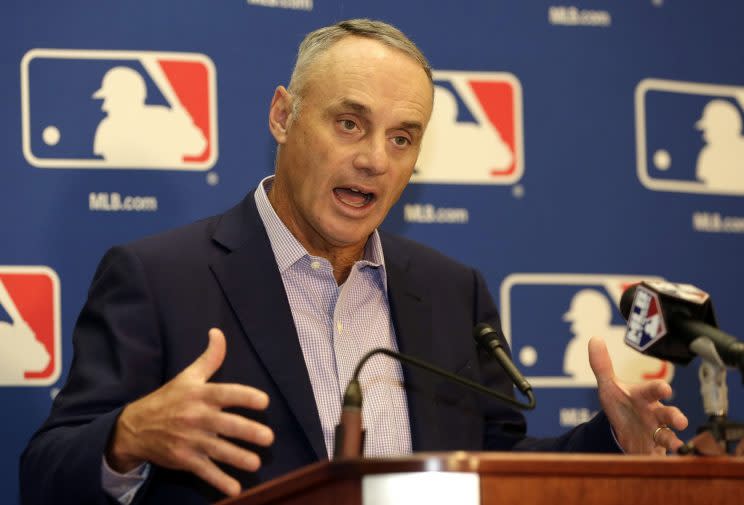MLB sends memo to teams claiming 'no evidence' the ball is juiced
Major League Baseball says there’s no conspiracy regarding its baseball. The league sent out a memo to all 30 teams Saturday which concluded “there is no evidence that the composition of the ball has changed in any way.”
The memo, which was obtained by Bob Nightengale of USA Today, outlined the testing process each ball undergoes before it is approved by the league. Here’s the key passage of the memo from Nightengale:
The memo’s summary reads: “The baseball in use today tests well within the established guidelines on every key performance metric. Furthermore, there is no evidence that the composition of the ball has changed in any way that would lead to a meaningful impact on on-field play.”
The first part of MLB’s statement is technically true. Every ball tested by the league, and by independent researchers, has concluded that the balls are within the “established guidelines.” There are, however, some pretty legitimate questions concerning whether the guidelines are far too lenient.
Research performed by Ben Lindbergh of The Ringer, which was co-authored by sabermetrician Mitchel Lichtman, first brought this issue to light. The two purchased 36 game-used balls, and then sent them for testing at Washington State University. Seventeen of those balls were used in games prior to the 2015 All-Star Game, which is around the time the recent home run surge started.
[Fantasy Football is open! Sign up now]
Their experiment resulted in two major conclusions: The ball’s COR, or bounciness, had increased, and the seams had been slightly lowered.
Both of those changes were small, but significant. Lindbergh and Lichtman estimated the changes could add roughly 7.1 feet to the distance each ball travels. That could explain why MLB is on pace to obliterate the all-time single-season home run record this year.
As stated above, though, both the heightened COR and the lowered seams fall within MLB’s “established guidelines” for balls. Lindbergh and Lichtman, however, refer to those as “laughably large.”
One study, released in 2000, concluded “two baseballs could meet MLB specifications for construction but one ball could be theoretically hit 49.1 feet further.” Even tiny differences, like the ones found by Lindbergh and Litchman, could make a huge difference.
While that research technically confirms MLB is right about the balls falling within the testing range, its findings seem to invalidate the second part of MLB’s statement.

Now, in fairness, a sample of 36 balls isn’t exactly large. But in case you were skeptical about those findings, Rob Arthur of 538 decided to take things a step further.
Arthur looked at drag, and determined that balls had a lower drag coefficient this season. A lower drag coefficient, in Arthur’s words, “ought to lead to longer fly balls and more dingers.” Arthur’s piece does a great job looking at the issue, and you should definitely read the whole thing.
In summary: Lindbergh and Litchman determined balls are bouncier and their seams are slightly lowered. Arthur concluded that was leading to lower drag on each ball. Both suggest the current balls are traveling farther.
Still skeptical? Well, how else are you going to explain this year’s home run barrage? Home runs are up nearly 47 percent this season. The league is on pace to shatter the all-time single-season record of 5,693, which was set in 2000. You know, the middle of the “Steroid Era.” At about the halfway point of the season, the league has seen 3,067 home runs hit this year.
OK, fine. So let’s say you’re a person who hates science, research and stats. Let’s say you’re the type who needs to rely on what the players say and think. Well, some of them also believe the balls are different. Brad Ziegler, David Price and Justin Verlander are among some of the names willing to speak out about the balls. A handful of guys who grip the ball every day have gone on record saying something is fishy.
MLB disagrees. Perhaps that should be expected. The league would prefer any and all changes be natural. Whether it was intentional or accidental, it does appear the ball is having a big impact on home runs this season. MLB can deny that for now, but it’s looking like the conspiracy theorists may have a point here.
More MLB coverage from Yahoo Sports:
– – – – – – –
Chris Cwik is a writer for Big League Stew on Yahoo Sports. Have a tip? Email him at christophercwik@yahoo.com or follow him on Twitter! Follow @Chris_Cwik


